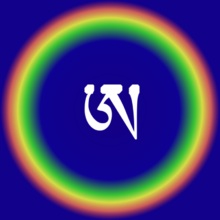Dzogchen - Tibetan Teachings On Our Natural State

 Dzogchen, often translated as 'Great Perfection' or 'Total Completeness', is a set of teachings and practices taught within the Nyingma school of Tibetan Buddhism, as well as other Tibetan branches. Dzogchen also refers to the primordial, natural condition of mind that these teachings and practices facilitate realization of. Through Dzogchen practices and meditation we come to recognize this as our own natural condition.
Dzogchen, often translated as 'Great Perfection' or 'Total Completeness', is a set of teachings and practices taught within the Nyingma school of Tibetan Buddhism, as well as other Tibetan branches. Dzogchen also refers to the primordial, natural condition of mind that these teachings and practices facilitate realization of. Through Dzogchen practices and meditation we come to recognize this as our own natural condition.According to Dzogchen teachings, the natural condition of all sentient beings, and of all reality, is pure, undifferentiated, timeless awareness. All form in the world – all that we experience as 'objective' reality - is an expression of this awareness, but ultimately this awareness is not affected by these expressions. One symbol often used to describe Dzogchen is a mirror, which reflects an object completely, but is not itself impacted by the object it reflects.
Dzogchen is often referred to as a philosophy of nondualism, because it does not posit subject and object, or emptiness and form, as two distinct – or dual – realities. Dzogchen isn't a transcendent reality or ideal level of being that can be understood as separate from us and our physical reality, but neither can it be understood as only existing within us. Referring to Dzogchen as a philosophy is not quite correct, because realizing it is not an intellectual understanding. While some of the teachings do provide mental constructs for attaining a knowledge of Dzogchen, ultimately that knowledge is through direct experience.
Because of this, Dzgochen places a strong emphasis on direct transmission from a teacher, in addition to oral and symbolic transmission. Dzogchen meditation practices facilitate a letting go of mental constructs that block our view of Dzogchen. Dzogchen master Chogyal Namkhai Norbu puts it this way:
"Dzogchen could be defined as a way to relax completely. This can be clearly understood from the terms used to denote the state of contemplation, such as 'leave it just as it is' (cog bzhag), 'cutting loose one's tension' (khregs chod), 'beyond effort' (rtsol bral), and so on. Some scholars have classified Dzogchen as a 'direct path', comparing it to teachings such as Zen, where this expression is often used. In Dzogchen texts, however, the phrases 'direct path' and 'nongradual path' (cig car) are never used, because the concept of a 'direct path' implies necessarily that there must be, on the one hand, a place from which one departs, and on the other, a place where one arrives. But in Dzogchen there is a single principle of the state of knowledge, and if one possesses this state one discovers that right from the beginning one is already there where one wants to arrive. For this reason the state is said to be 'self-perfected' (lhun grub)." - from Dzogchen: The Self-Perfected State
Dzogchen practices and meditations reflect this idea that Dzogchen both is and is not a process of discovery or transformation. They revolve around seeing through mental constructs that block our realization of this natural condition, and then attempting to stabilize this 'View'. Ultimately, there is no differentiation between realizing Dzogchen in meditation and in daily life. As one Dzogchen master put it when asked if he still meditated, "When am I ever distracted?"
The symbol for Dzogchen (shown above) is the Tibetan A, surrounded by a circle of rainbow light. The A represents Dzogchen as emptiness, or undifferentiated awareness, while the rainbow light represents it as form, or all worldly representations of this natural state.
For more information on Dzogchen, try:
You Should Also Read:
Yantra Yoga by Chogyal Namkhai Norbu
The Four Schools of Tibetan Buddhism

Related Articles
Editor's Picks Articles
Top Ten Articles
Previous Features
Site Map
Follow @mommymystic
Tweet
Content copyright © 2023 by Lisa Erickson. All rights reserved.
This content was written by Lisa Erickson. If you wish to use this content in any manner, you need written permission. Contact Lisa Erickson for details.


